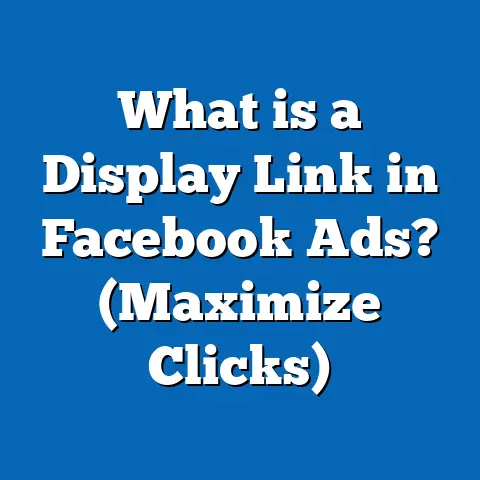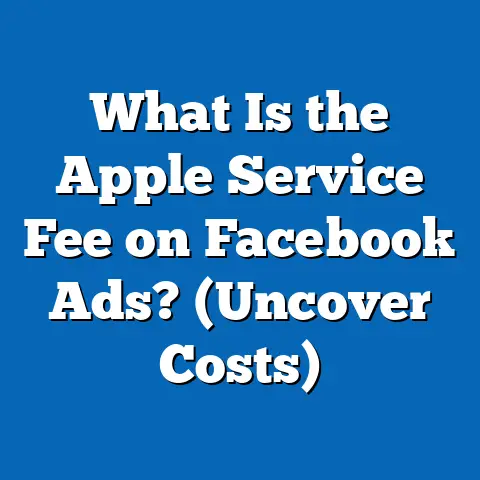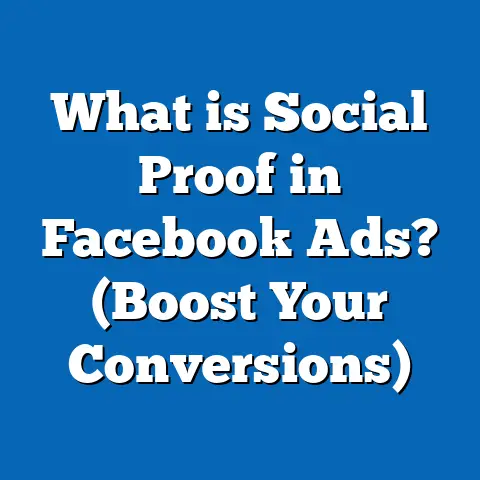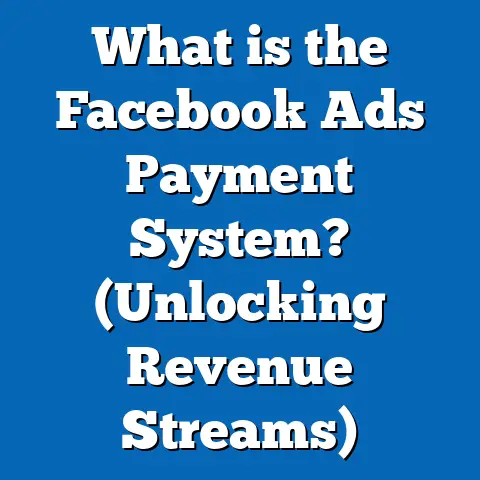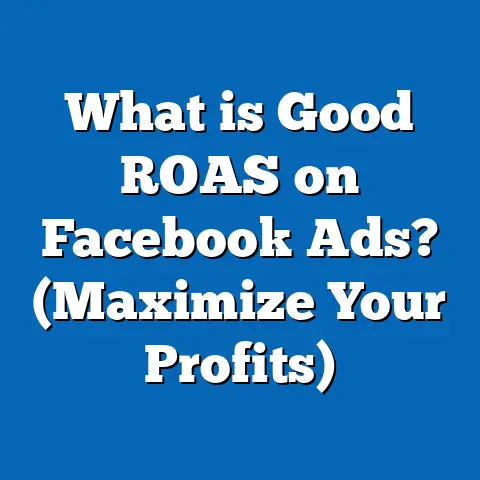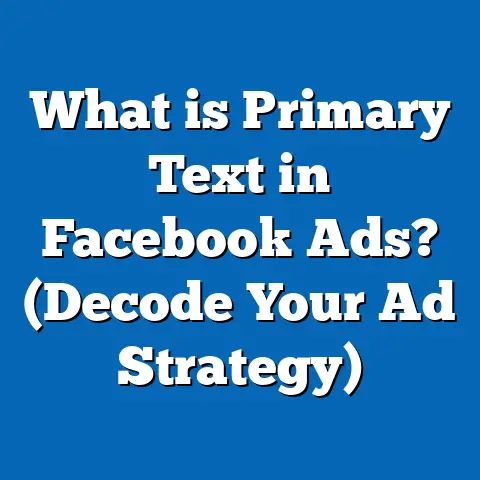What is Good Hold Rate in Facebook Ads? (Maximize ROI)
What is Good Hold Rate in Facebook Ads? (Maximize ROI)
Introduction: Remember When TV Ads Held Our Attention?
Do you remember the days when TV commercials were the only way businesses reached their audience? We often waited eagerly for our favorite shows, hoping the ads wouldn’t make us switch channels. That nostalgia highlights how valuable “hold rate”—the ability to keep an audience engaged—has always been in advertising. The concept remains just as important in the digital age, especially for Facebook ads, where countless brands compete for attention in a crowded feed.
In this guide, you’ll learn what hold rate means in Facebook advertising, why it matters, what benchmarks to aim for, and practical ways to improve it. We’ll also explore real-world examples and advanced insights so you can maximize your return on investment (ROI) by keeping viewers locked in.
Understanding Hold Rate in Facebook Ads
What Is Hold Rate?
Hold rate is a metric that reflects the percentage of viewers who continue watching your video ad after it begins. It essentially measures engagement by showing how many people don’t scroll past or skip your ad immediately.
In Facebook ads, hold rate is measured mainly through video metrics like:
- Video Average Watch Time: The average amount of time users spend watching your video.
- Video Retention Rate: The percentage of viewers still watching at given time intervals.
- ThruPlay: Counts the number of times your video was played to completion or for at least 15 seconds.
Hold rate serves as a proxy for the quality and relevance of your ad content. A higher hold rate indicates your creative is captivating enough to keep users engaged.
Why Does Hold Rate Matter?
Hold rate directly impacts your campaign performance and ROI because:
- Facebook’s Algorithm Rewards Engagement: Ads with higher hold rates get better relevance scores, leading to wider delivery at lower costs.
- Reduced Cost Per Result: Engaged viewers are more likely to convert, reducing costs for clicks, leads, or sales.
- Improved Brand Recall: Longer watch time means better message retention and increased brand awareness.
- Audience Insights: High hold rates reveal which creative elements resonate with your target market.
Put simply, hold rate is not just vanity data—it’s a critical indicator of whether your ads are effectively communicating and persuading.
What Constitutes a Good Hold Rate?
Industry Benchmarks and Data
Hold rates vary widely across industries, ad lengths, and audience segments. To set realistic goals, here are some industry averages and benchmarks based on recent studies and platform reports:
| Metric | Average Benchmark | Top Performers |
|---|---|---|
| Video Retention at 15 seconds | ~45% | 60%+ |
| Hold Rate for <15 second videos | 70% or higher | 80%+ |
| Video Average Watch Time | 6-10 seconds (for videos 15-30s) | 12+ seconds (engaging videos) |
For example, according to a 2023 Social Media Examiner report analyzing over 10,000 Facebook video ads:
- The average viewer watches about 45% of a 15-second video.
- Shorter videos under 15 seconds tend to retain up to 70-80% viewers.
- Highly targeted campaigns with personalized creative can push hold rates beyond 60%.
What Influences Hold Rate?
Several factors affect hold rate on Facebook ads:
- Ad Length: Shorter ads generally have higher hold rates because they demand less time commitment.
- Creative Quality: High-quality visuals, clear messaging, and engaging storytelling improve retention.
- Audience Relevance: Ads targeted precisely to interested users keep attention longer.
- Ad Placement: Feed placements usually yield better hold rates than Stories or Reels due to user behavior.
- Device Type: Mobile users dominate Facebook traffic; mobile-optimized formats perform better.
Understanding these factors helps craft ads that hold viewer attention and deliver superior results.
How to Measure Hold Rate Effectively on Facebook
Key Metrics Explained
Facebook’s Ads Manager provides various metrics tied to video engagement. Here’s how to interpret them for assessing hold rate:
| Metric | Definition | Why It Matters |
|---|---|---|
| Video Average Watch Time | Average seconds watched per view | Indicates general engagement level |
| Video Retention Rate | Percentage of viewers watching at specific seconds | Reveals drop-off points and engagement trends |
| ThruPlay | Number of times video viewed to completion or 15 seconds | Shows how many users watch most or all of video |
By combining these metrics, advertisers can identify how well their videos retain attention and adjust accordingly.
Using Facebook Analytics Tools
In addition to Ads Manager data, Facebook offers tools such as:
- Breakdowns: Segment retention by age, gender, location, placement, device.
- Heatmaps: Visualize drop-off points within videos.
- Facebook Audience Insights: Understand audience behavior patterns.
Regularly reviewing these insights supports data-driven decisions to optimize hold rate.
Improving Your Hold Rate: Practical Strategies
Optimize Video Content
Your creative is the foundation of hold rate. Follow these best practices:
- Start with a Strong Hook: Capture attention within the first 3 seconds using curiosity, emotion, or value propositions.
- Use Captions: Over 85% of Facebook videos are watched without sound. Captions ensure your message isn’t lost.
- Keep Videos Concise: Aim for 6-15 seconds for ads focused on engagement. Longer videos need strong storytelling.
- Tell a Story: Use narrative techniques that build curiosity or connect emotionally.
- High Production Quality: Clear visuals, good lighting, and professional editing help maintain viewer interest.
Target the Right Audience
Relevance drives retention:
- Use Custom Audiences to retarget website visitors or past engagers.
- Leverage Lookalike Audiences to reach similar profiles likely interested in your product.
- Narrow targeting by demographics or behaviors to avoid wasting impressions on uninterested users.
Test Different Ad Placements
Facebook offers multiple placements:
- News Feed: Often yields high engagement due to natural scrolling behavior.
- Stories: Fast-paced; requires vertical format but often lower hold rate.
- In-stream Video Ads: Mid-roll ads within longer videos; can perform well if aligned with content.
Test placement performance regularly and allocate budget toward those with highest hold rates.
A/B Testing for Continuous Improvement
Experiment with elements such as:
- Video length variations
- Different hooks or opening scenes
- Calls-to-action placement
- Visual style changes
Use split testing to identify which versions capture and maintain viewer attention best.
Case Study: Boosting Hold Rate for an E-commerce Brand
Background
A mid-sized fashion e-commerce brand experienced low engagement on their Facebook video ads. Their original videos averaged a hold rate of only 30% at 15 seconds and their cost per acquisition (CPA) was relatively high.
Strategy Implementation
The brand worked through these steps:
- Shortened Videos: Reduced length from 30 seconds down to 10 seconds.
- Stronger Opening: Highlighted key product benefits in first 3 seconds.
- Captions Added: Ensured message clarity even on mute.
- Targeted Custom Audiences: Focused on website visitors who browsed but did not purchase.
- Clear CTA: Added direct call-to-action encouraging immediate purchase.
Results After Three Months
- Hold rate increased from 30% to 65% at 15 seconds.
- CPA dropped by 35%, indicating more efficient conversions.
- Return on Ad Spend (ROAS) improved from 3x to 5x.
- Overall campaign reach increased as Facebook favored better-performing ads.
This case demonstrates how focusing on hold rate can lead to measurable improvements in ad effectiveness and business outcomes.
Advanced Insights: Comparing Hold Rate Across Platforms
Understanding how Facebook compares with other platforms helps marketers tailor content appropriately:
| Platform | Average Video Hold Rate | Ideal Video Length | Key Features Influencing Hold Rate |
|---|---|---|---|
| ~45% at 15 sec | 6-15 sec | Granular targeting & multiple placements | |
| ~40% at 15 sec | 6-15 sec | Visual-first; Stories & Reels dominate | |
| YouTube | ~50% at 30 sec | 15-30 sec | Longer content expected; skippable ads |
| TikTok | ~55% at 15 sec | 9-15 sec | Highly engaging short-form content |
Key Takeaway: While TikTok may have higher average retention due to its viral short-video format, Facebook’s strength lies in precise targeting and placement options that can be leveraged for tailored engagement strategies.
Common Misconceptions About Hold Rate
Misconception 1: “Longer Videos Always Perform Worse”
While shorter videos tend to get better hold rates on average, longer videos with compelling content can maintain strong retention. The secret lies in pacing and narrative quality.
Example: A charity campaign told a heartfelt story over a 60-second video with a hold rate above industry average because it connected emotionally.
Misconception 2: “High View Count Means High Engagement”
View count measures reach but doesn’t capture engagement depth. A video with millions of views but low average watch time signals weak hold rate and poor ROI.
Focus on metrics like average watch time and retention curves instead.
Technical Concepts Made Simple
How Does Facebook Calculate Hold Rate?
Facebook derives hold rate from the video retention curve—tracking how many viewers remain watching at each second of the video. Formally: Hold Rate at time t=Number of viewers still watching at tNumber of viewers at start×100%\text{Hold Rate at time } t = \frac{\text{Number of viewers still watching at } t}{\text{Number of viewers at start}} \times 100\%
For example, if you start with 1,000 viewers and only 400 remain at the 10-second mark, your hold rate at 10 seconds is: 4001000×100%=40%\frac{400}{1000} \times 100\% = 40\%
This retention curve helps identify drop-off points where viewers lose interest.
What is ThruPlay?
ThruPlay counts video views that last at least 15 seconds or until completion if shorter than 15 seconds. It is a key metric for campaigns optimized for video engagement or conversions because it measures meaningful viewing rather than just impressions.
Practical Tips to Maximize ROI Using Hold Rate
Step-by-Step Guide
- Define Clear Objectives
Decide whether your goal is brand awareness, lead generation, or sales conversion because this will influence ideal video length and messaging style.
- Create Engaging Creative
Focus on storytelling that hooks early and maintains interest. Use captions and strong visuals optimized for mobile devices (~98% of Facebook users).
- Segment Your Audience
Use Custom Audiences for retargeting and Lookalikes for prospecting. Narrow targeting improves relevance which boosts hold rate.
- Test Different Formats & Placements
Experiment with Stories, Feed, In-stream videos, and Carousel formats while monitoring hold rates closely by placement.
- Monitor Frequency
Limit ad frequency to avoid viewer fatigue which lowers retention over time. Rotate creatives regularly.
- Analyze Data & Optimize
Review analytics weekly; refine targeting and creative based on which ads yield highest average watch time and retention.
Future Trends Affecting Hold Rate in Facebook Ads
AI Personalization Will Increase
Facebook’s machine learning algorithms will become more sophisticated at delivering ads likely to engage each individual user, boosting hold rates through hyper-personalization.
Shift Toward Short-Form Video Dominance
With TikTok’s rise influencing social media consumption habits, platforms like Facebook are prioritizing Reels and short videos under 15 seconds that naturally have higher retention potential.
Growth in Interactive & AR Ads
Augmented Reality (AR) ads and interactive formats that invite user participation will likely improve hold rates by making ads more immersive and memorable.
Additional Case Studies & Examples
Case Study #2: SaaS Company Increasing Demo Signups Through Better Hold Rates
A SaaS company running Facebook video ads promoting free demos saw an initial low video retention (~25%) and poor demo signups.
They revamped their approach by:
- Creating shorter (10-second) explainer videos highlighting key pain points upfront.
- Adding captions emphasizing benefits clearly.
- Targeting small business owners through Custom Audiences.
Outcome:
- Hold rate rose from 25% to over 55%.
- Demo signups increased by 40%.
- Cost per signup dropped by nearly half within two months.
Example: Using Polls & Interactive Elements to Boost Engagement
Facebook allows interactive polls inside some ad formats. Adding questions related to the product increases viewer interaction time, thereby improving hold rates indirectly by encouraging active participation instead of passive viewing.
Frequently Asked Questions (FAQs)
Q1: What’s the difference between hold rate and click-through rate (CTR)?
Hold rate measures how much of your video ad people watch; CTR measures how many click your ad link. High hold rate often leads to better CTR but they measure different user actions.
Q2: Can I improve hold rate without changing my creative?
Yes—improving targeting precision or adjusting placements can increase relevance and boost hold rate without altering the creative itself.
Q3: Does ad frequency affect hold rate?
Yes—higher frequency can cause ad fatigue leading to lower retention as users become bored or annoyed seeing the same ad repeatedly.
If you want me to provide additional sections (like deeper statistical analysis or a fully detailed action plan with templates), please let me know!

